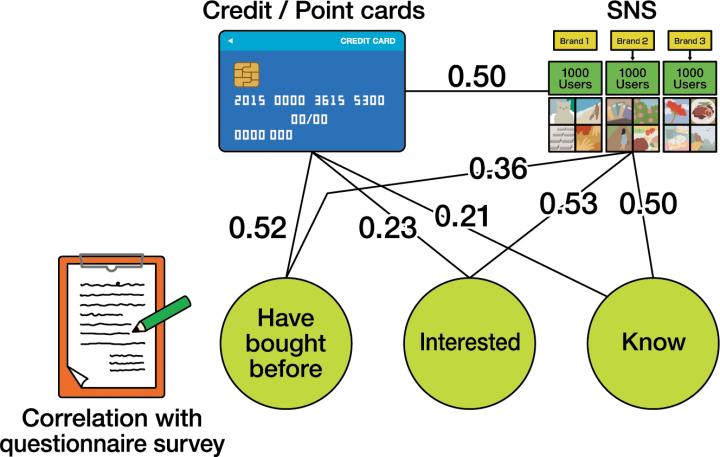A new algorithm analyzes social media data to help brands improve their marketing

Credit: © 2020 Yamasaki et al.
Researchers created an algorithm that successfully predicted consumer purchases. The algorithm made use of data from the consumers’ daily activity on social media. Brands could use this to analyze potential customers. The researchers’ method combines powerful statistical modeling techniques with machine learning-based image recognition.
Associate Professor Toshihiko Yamasaki and his team from the Graduate School of Information Science and Technology at the University of Tokyo explore new and interesting ways to make use of data such as social media data. Some applications they develop are useful for entities like companies to improve their effectiveness in different ways, but in particular in how they reach and influence potential customers.
“I posed two questions to my team: ‘Is it possible to calculate the similarity between different brands based on the way customers engage with them on social media?’ And, ‘If so, can brands use this information to improve the way they market themselves?'” said Yamasaki. “And with some time, effort and patience, they came back with a simple but confident answer: ‘Yes!'”
But the way their team deduced this was anything but simple. The computational analysis of social media data is often called mining, as the term suggests it is a monumental and laborious task. For this reason, researchers in this field make use of various computational tools to analyze social media in ways that human beings cannot.
“In the past, many companies improved their marketing strategies with the use of customer surveys and projections based on their sales data,” explained lead researcher Yiwei Zhang. “However, these are time-consuming and imprecise. Now we have access to and expertise in tools such as machine learning and complex statistical analysis.”
The team began its work by gathering publicly available social media data from followers of selected brands. They used proven image recognition and machine-learning methods to analyze and categorize photos and hashtags relating to the brands’ followers. This revealed patterns of behavior of consumers towards different brands. These patterns meant the researchers could calculate the similarity between different or even unrelated brands.
“We evaluated our proposed algorithm against purchase history and questionnaires, which are still useful to provide context to purchase information,” continued Zhang. “The experimental results show that credit card or point card companies could predict customers’ past purchasing behavior well. Our algorithm could accurately predict customers’ willingness to try new brands.”
This research could be extremely useful for new promotions of brands that make use of social media networks. It could also be used by shopping centers and malls to plan which stores they include or for stores themselves to choose which brands to stock. And the research could even help match brands with suitable social media influencers to help better advertise their products.
“To visualize what has not been visible before is always very interesting,” concluded Yamasaki. “People might say that professionals already ‘see’ these kinds of patterns, but being able to show the similarity between brands numerically and objectively is a new innovation. Our algorithm is demonstrably more effective than judging these things based on intuition alone.”
###
Media Contact
Toshihiko Yamasaki
[email protected]
81-358-416-698
Original Source
https:/
Related Journal Article
http://dx.




